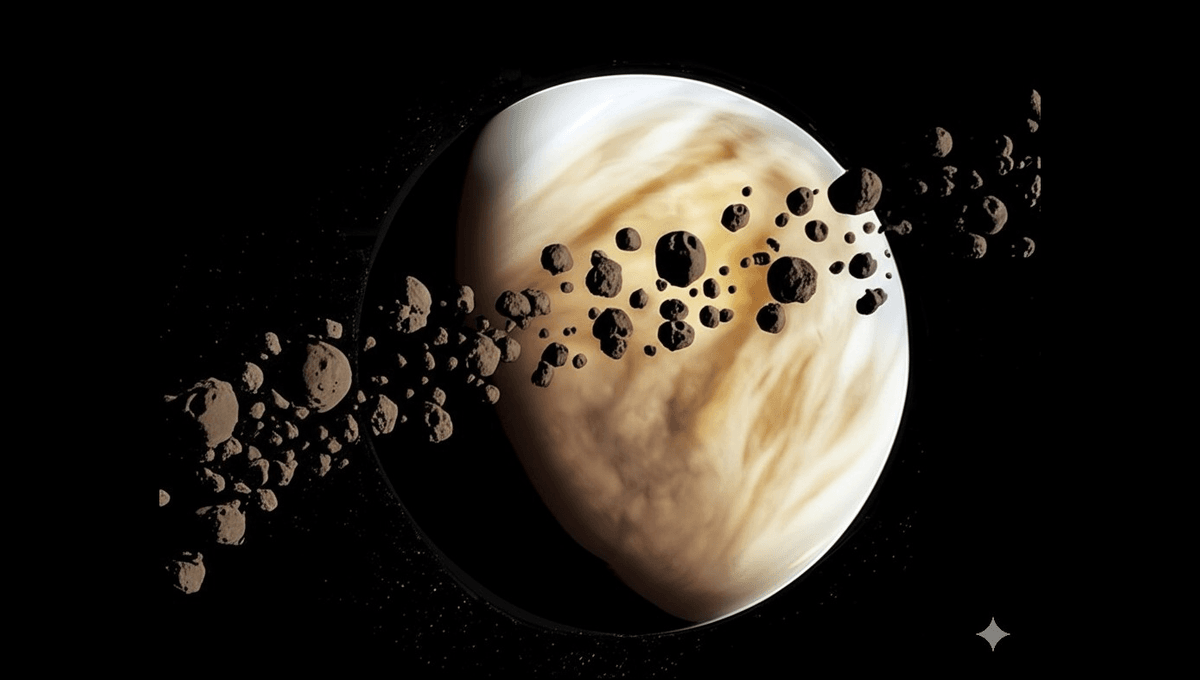
Venus probably shares its orbit with numerous asteroids with unstable orbits, and these could represent one of the most unpredictable threats to Earth from space. We’ve only found a few of these objects, but a new study notes that given how hard it is to find them, the sample we have indicates there must be many more.
Recent decades have seen a flood of discoveries of potentially hazardous asteroids (PHAs) that cross Earth’s orbit, and might one day collide with us. The Vera Rubin telescope is already picking up the pace of discovery.
Unfortunately, even the Vera Rubin will struggle to find a subgroup of PHAs – objects whose orbits barely reach out as far as Earth. New research suggests there are probably more of them than we have suspected.
“Our study shows that there’s a population of potentially dangerous asteroids that we can’t detect with current telescopes. These objects orbit the Sun, but aren’t part of the asteroid belt, located between Mars and Jupiter,” Professor Valerio Carruba of São Paulo State University said in a statement. “Instead, they’re much closer, in resonance with Venus. But they’re so difficult to observe that they remain invisible, even though they may pose a real risk of collision with our planet in the distant future.”
The asteroids are invisible not because they are made of glass, but because we never get to see them fully lit up. Like the Moon, they go through phases from our perspective, and like Mercury and Venus we’d never see them full because at that point they would be on the other side of the Sun. Being so much smaller than the inner planets, they’re too faint to detect when half-lit up when a quarter of an orbit ahead or behind us.
Despite these difficulties, we have detected 20 Venus co-orbiters, of which Zoozve is by far the most famous. However, Carruba and coauthors argue there must be vastly more for us to have found the ones we have, given the odds against detection.
“These objects enter into 1:1 resonance with Venus, which means that they complete one revolution around the Sun in the same time as the planet,” Carruba said.
Sharing an orbit with a planet is not unusual; the spacecraft Lucy is on its way to check out Jupiter’s Trojans because there are thought to be so many of them. However, these orbits are highly stable. It’s suspected Earth has plenty of its own Trojans that we’ve never seen, which also are not considered a problem.
However, Carruba and coauthors argue that Venusian co-orbitals are highly unstable. Venus’s own orbit is the most circular in the Solar System, but its known co-orbiters are quite eccentric. That means that while their average distance from the Sun is the same as Venus, they can travel much further in and out, often enough to encounter Mercury and Earth. Ironically, the one planet they won’t hit is Venus, as co-orbital status prevents close approaches.
Nineteen of the 20 known Venusian co-orbiters have an eccentricity greater than 0.38 (where zero means perfect circularity), the value required for a co-orbiter to reach our own orbit.
Carruba and coauthors think that’s not because such elongated orbits are the norm. Instead, orbits stretched enough to push them past the Earth, even just briefly, are almost a precondition for detection. The more eccentric these asteroids’ orbits are, the better our chance of having seen them.
Venus’s co-orbiters with low eccentricity are not an immediate problem, as they don’t come out far enough to hit us. Unfortunately, objects in these kinds of orbits can change their eccentricity quite fast.
Carruba’s calculations indicate that the eccentricity of these objects goes through sharp transitions, averaging about once every 12,000 years.
“During these transition phases, the asteroids can reach extremely small distances from Earth’s orbit, potentially crossing it,” Carruba said.
That means that any particular Venus co-orbiting PHA could currently be on an orbit that keeps it well inside Earth’s, and therefore undetected, before a transition suddenly creates a high chance of hitting Earth or the Moon.
Currently, at least three of the 20 Venus co-orbiters have orbits that can bring them five times closer than the Moon to Earth; there are probably many more that will shift to such orbits at some point.
Most such Venus co-orbiters would be small enough to do little or no damage, but if the population is numerous enough, there could still be plenty of dangerous size. Zoozve is estimated to be 200-500 meters across (660 to 1,640 feet). “Asteroids about 300 meters in diameter, which could form craters 3 to 4.5 kilometers wide and release energy equivalent to hundreds of megatons, may be hidden in this population,” Carruba said. “An impact in a densely populated area would cause large-scale devastation.”
After all, 2024 YR4’s is considered a threat we might need to deal with at just 60 meters across, despite being no direct threat to the Earth, and five times the width means more than 100 times the mass.
Carruba and coauthors calculate even the Vera Rubin would only be able to detect such objects during a short window each orbit. “Planetary defense needs to consider not only what we can see, but also what we can’t yet see,” Carruba said.
The authors consider the potential of a telescope in space located closer to the Sun, possibly at Venus’s L2, and conclude that this may be what is needed.
The study is open access in Astronomy and Astrophysics.
Source Link: “Invisible” Asteroids Near Venus Could Pose One Of Most Unpredictable Threats To Earth